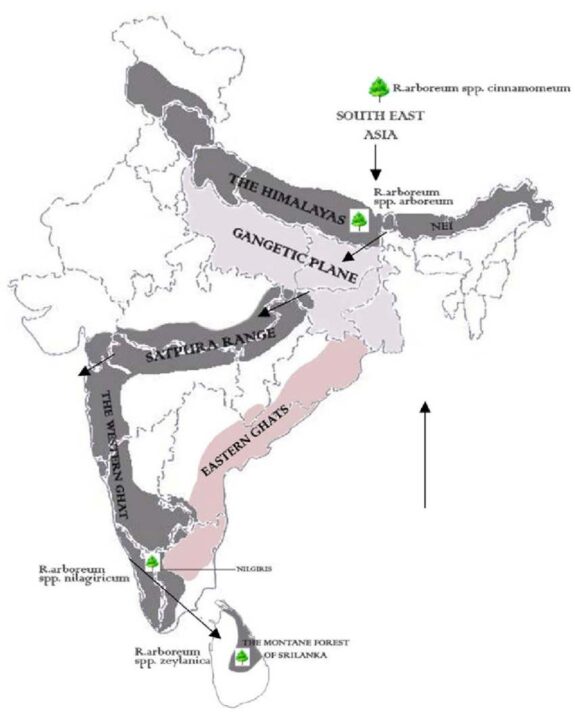SATPURA AND VINDHYACHAL’S MAGNIFICENT MOUNTAIN RANGES DEFINE THE CENTRAL INDIAN REGION, WITH IMPORTANT CITIES LIKE JABALPUR, BHOPAL, NAGPUR, AND CHHINDWARA FLOURISHING IN THEIR NEIGHBOURHOODS.
In the critical times when climate change is sweeping the world and is more real than ever before, it is difficult to really segregate urban landscapes from rural ones because of the importance of mountains, forests, and rivers. The benefits of these natural assets or resources are almost always derived by urbanites, be it water or wellness therapies that originate from forests. There should be no two opinions about the same thing. The class of urban neo-rich go out in big numbers to explore newer and newer places and spend a lot on tourism activities, especially after the COVID-19 outbreak. The pristine forests of the Satpura mountain ranges not only provide freshwater, but they also provide clean air to breathe when Indian cities are reeling under heavy dust particles and related pollution.
The long and undulating stretches of the two famous mountains are a treasure trove for nature lovers. Splendid Satpura Hills provide shelter to thousands of birds, bees, other insects, and animals, though much less is known about this vast region close to Bhopal, with Pachmarhi as the ever-in-demand tourist destination.
A plethora of books on wildlife and forests are available these days, mainly because people have understood the importance of nature. Many of them are in my ever-growing private library, giving details of tigers and lions, elephants and rhinos, and so on. Mostly, the wildlife books have tigers on their covers, and they tend to focus on the mega mammals. Well, the one under review—a classic coffee table book—has a sloth bear on its beautifully designed cover, and the book talks about the entire landscape of Satpura National Park near Bhopal. Author-editor Aly Rashid, a very low-profile hotel entrepreneur, has put together an unputdownable collection of his experiences in that lovely forest that harbours a range of wildlife. The floral and faunal diversity of Satpura can beat any protected forest in the country hands-down. The tiger reserve as an ideal wild habitat is comparable to the famous Kanha National Park, according to some experts. Aly calls it his own “tryst with this mystical wilderness’’ and provides us with a rare insight into the age-old jungle, largely unexplored but next to an urban settlement like Hoshangabad.
He has taken with him India’s top wildlife photographer, Shivang Mehta, who has enriched the book with his breathtaking images not only of tigers but also of the less celebrated creatures like Indian porcupines, sloth bears, and jungle cats, among others. India’s wellknown tree man, Pradip Krishen, who has written a great book, Trees of Delhi, has also richly contributed to the volume by presenting many lesser-known facts about the land, trees, and people. He traces the history from the Gond Kingdom to Nagpur’s Maratha King Raghoji Bhonsle to the British rule— who all had sway over this picturesque land at different points in history—to tell us how richly endowed the region has been. Pachmarhi is the famous landmark of the Satpura landscape, which is the Central Indian Highlands. It was here that Pradip Krishen, according to his admission, was introduced to trees. His incredible journey from a filmmaker to an acclaimed environmentalist began in Madhya Pradesh’s Satpura forests.
Aly, himself a lovely lensman, has been visiting Satpura since his childhood. After quitting his corporate job, he threw himself into wildlife conservation. Though his family runs a top hospitality business, with Bhopal’s Jehan Numa Palace (heritage) hotel being the best in central India, Aly and his brother Fazal Rashid spend more time in the Satpura jungles, trying to learn more about trees and tigers, flowers and giant squirrels (the mascot of the NP), bison, and leopards while overseeing their two marvellous properties nearby.

The glossy book is divided into 13 chapters, some of which are written by domain experts, and shows all sides of Satpura—floral and avian diversity, tigers, and the five rivers that flow around the sprawling and verdant tiger reserve—Tawa, Denwa, Sonbhadra, Malini, and Naghduari. Aly says, “The riparian ecosystems formed by these rivers are home to crocodiles, freshwater fish, and the first known record of the Eurasian otter in Central India.” The book details the nature and sightings of sloth bears, wild dogs, and birds, but does not ignore the jungle king—tigers. He writes, “Tiger in Satpura has a fairly large territory in comparison to other landscapes in central India. Because of the low density of prey in the northern area, the tiger would not be resident in a place like Madhai but rather transient, emerging once a week to a ten-day cycle.” The book has a separate chapter on famous tigresses like Jokerface, Shy Female, Sudiya, KT, Ravan, R2, Malini, Heartface, and Machli, who all appear in the book with the author’s observations about them over the years of personal sightings. “Satpura Tiger Reserve has been a hidden gem that is now getting its due appreciation,” says L Krishnamoorthy, Field Director of Satpura.
The author has highlighted a quotable quote of Mahatma Gandhi that says, “What we are doing to the forests of world is but a mirror reflection of what we are doing to ourselves and to one another”
Many experts believe that if forests are not preserved, our cities will die soon. The constant encroachments in the Aravallis and felling of trees there are heavily and negatively impacting the national capital, Delhi, a fact underlined by the never-ending severe air quality and associated smog.
In that sense, a book on the unexplored Satpura holds out hope for tomorrow
